#( eh. it'll do )
Text
lil doodle to end the week

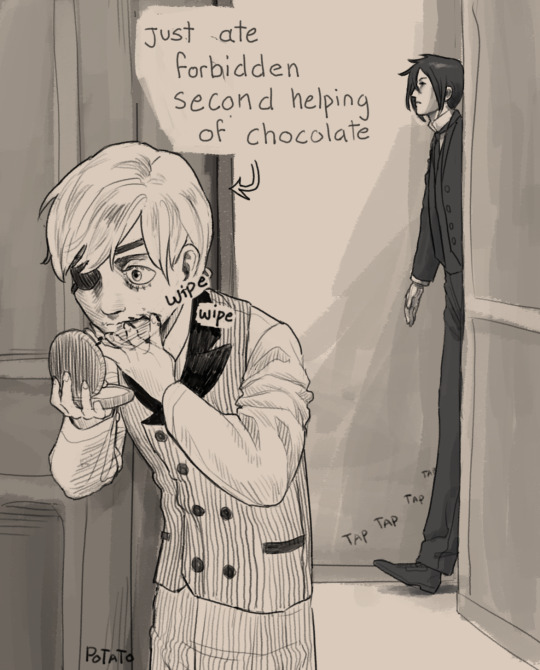

#dunno why I come up with little scenarios that focus on such minute details. lol anyway I GOTTA improve my line shading#my crosshatching has taken a dip. gotta pick it back up again#kuroshitsuji#black butler#kuroshitsuji fanart#fanart#sebastian michaelis#ciel phantomhive#digital art#elizabeth midford#lizzy midford#sketch#also wow I can't believe i missed reaper day. I was literally doing something and then got side tracked but i didnt stop myself cause i#thought 'eh I have time'#oh well it'll be done someday. plus i didn't see yana do anything so far so I guess i didnt miss such a big holidays after all...#welp it's expected. be happy for the reapers anyway!!!
3K notes
·
View notes
Text

💇🏽♂️🤔
#ore no kao#gay#i was trying to think of tdcc or vaccines lyrics for this but i need to sleep for the office tmrw 😩#quarterly hair trim announcement it is#did mean to tell the guy not to trim my beard/'stache too much but eh i think it'll grow on me#took a few but liked this one hehe#[also haven't posted one like this in a while#need to do a progress check with the last one hmm]#anyway bye 😴😴#[alternatively would have done red rum club lyrics too]
272 notes
·
View notes
Text


BALAK, PANGAGAD
uhhh conspiracy. can be a courtship dance. ritual. so to speak. & hosting one in your house is an act of service
#(vague hand waving) gender or something as well. the romans sure do love discourses on identity. moving along!#i'm working on something that leads to a scene where Trebonius says that in a different life Cassius would've#made an ideal wife for someone. and Cassius is like. lmao. sure whatever. and it'll spiral out into bickering or whatever and Trebonius#would say something about how Cassius could've been a modern Lucretia. or something.#Cassius would of course return fire with Portia being their modern Lucretia for having to put up with Brutus during All Of That#EH. we're work shopping it. the more immediate one is when Cassius says that his name can handle the weight of a shared#conspiracy (incorrect it requires a sacrifice of Brutus but for a moment they can all indulge in a fantasy)#ANYWAY. back to courtship rituals. the conspiracy can also function as a barkada and serve as the go between#drawing tag#komiks tag#roman republic tag
126 notes
·
View notes
Text
alri I'm feeling generous tonight I'll give you folks the sketches (for the main 4) I just finished before I go sleeb
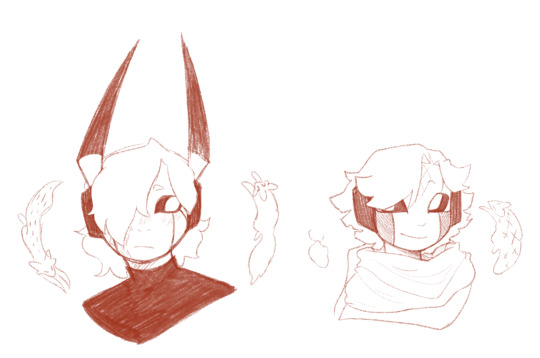

#don't mind how moon and pebs are like slightly more blurry than the other two#drew them a little too small and it's only the sketch so it'll look better when I actually line and color them#but also gotta do sos cw and ui so it may take a bit#idk I just want to actually give them colors because I have the ideas in my head I just never got them out#eh I'll tag this properly why not#rain world#seven red suns#five pebbles#looks to the moon#no significant harassment#gjinka bs#nighty night :3 *explodes*
197 notes
·
View notes
Text

I haven't posted in a while so here's some kiribaku
#I haven't been liking my art recently and this is the best I could bring myself to do tbh#But eh it'll pass—#Kiribaku#bakukiri#bakushima#krbk#Katsuki bakugou#eijirou kirishima#bakugou x kirishima#katsuki bakugou fanart#katsuki bakugou art#eijirou kirishima art#Eijirou kirishima fanart#Mha#Bnha#Mha art#Bnha art#my art#katsuki bakugou x eijirou kirishima#eijirou kirishima x katsuki bakugou#bakugou katsuki#kirishima eijirou
188 notes
·
View notes
Text
all this stream is telling me rn is badboyhalo cannot under any circumstances become president because if he becomes a federation puppet and gets turned against the players or the eggs the ENTIRE server is fucked
#qsmp#qsmp badboyhalo#bad: OH MY GOSH. WHAT IF (intricate break in plan that could ensure eggs die that i had not considered in my life)#just every 3 minutes he's like OH MY GOSH and comes up with a new reason their safe houses aren't safe#like SIR THEY MIGHT NEVER HAVE THOUGHT ABOUT DOING THAT IF YOU HADN'T#LETS NOT FORGET ELQUACKITY'S PLAN WAS 'eh blow stuff up' LIKE ???? BASIC AF#and here bad's like 'they could use the wand of symmetry to rig tnt in the egg rooms so it'll ignite when the trapdoors are activated!!!'#would that have crossed their minds??? WHO KNOWS!!!!!! BUT THEY SURE FUCKIN KNOW NOW!!!#nothing is secret on isla quesadilla once it's said out loud that idea is Public Domain#shut up vic#block game brainrot
232 notes
·
View notes
Note
hello, i have a question. what is the difference betwwen a hard and a dangerous racer? is there some sort of characteristics like how succesful a racer is or is more of a "a dangerous racer races on the limit and that's dangerous. a hard racer races on the limit but. its just a hard racer". thank you for answering!
completely in the eye of the beholder, I'm afraid. it's a perpetual debate, and one where everyone draws the line differently... very much a case of one man's dangerous manoeuvre is another one's hard but fair overtake... that being said! I'll have a go at coming up with a general framework with which people assess this stuff
let's bring in two strawmen, which feels like the most direct way to illustrate the possible stances you can take on this debate. to be clear, nobody really fits neatly in either ideological category - but, well, these are pretty much the two most extreme positions anyone could have:

when people are describing something as 'hard racing' (as opposed to... idk, 'clean' racing), they are usually talking about a) contact between the two bikes, and/or b) an action that forces the other bike to take evasive action. what constitutes forcing evasive action? well, this is all very nebulous and hard to define - there's crossing another rider's racing line, making them pick up the bike mid-corner, forcing them wide/off-track, not yielding in situations where one of you will have to yield to avoid a crash... but this is always an assessment that will depend on the specific circumstances. not every block pass is considered hard racing, for instance, even though you are quite literally 'blocking' the other bike. contact is the more straightforward one... if you initiate a move that leads to contact, then most people would agree this is 'hard' racing
so say you are in the 'A' camp. according to this line of thinking, pretty much every contact is 'dangerous' riding and should not be allowed. here's what gibernau said about jerez 2005, included in the sete post:


let's not discuss the merits of the jerez 2005 move specifically here - this is an expression of a broader ideological position. "this is not a contact sport" "it's not about hitting another guy"... so, according to this stance, actions that knowingly result in contact should not be acceptable and as a result need to be penalised. taken to the logical extreme, any and all 'hard racing' is dangerous
let's go to the other extreme, 'B'. let's say you're very pro-hard racing, to the point where you think that contact is more than fine and that it is unreasonable to call it 'dangerous'. sure, of course it is dangerous, but inherently all motorcycle racing has a lot of risk attached. racing that involves contact is basically acceptable. even within this extreme, my lovely venn diagram allows for some actual 'dangerous' riding - either behaviour that is wholly irresponsible during races... or stuff that doesn't count as hard racing because it's not 'racing'. here are some examples:
stuff that happens during races but is like... egregious misbehaviour. cf romano fenati pulling a rival's brake lever during a race - obviously dangerous and no longer really exists within the confines of actual racing
in either races or non-race sessions - not following proper safety procedures like for instance ignoring yellow flags. again, should be pretty obvious why that's dangerous
poor behaviour in non-race sessions,the general tag for not exhibiting appropriate care, awareness for your environment, all that stuff... the extreme example is marc barrelling into the back of another rider after the chequered flag had been waved in friday practise at phillip island 2011 (more on that here). it's also things like faffing about on the racing line, see the pecco mugello dramatics
so, yes, everyone will agree that there's some stuff that counts as 'dangerous riding' that's distinct from 'hard racing' just because it's not actual racing. that's the most straightforward stuff... but yeah, anyway, those are basically the two extreme positions you can take. you can say that all contact is bad and dangerous, that any time you're forcing another rider to take evasive action and are making a pass that isn't 1000% clean, you are putting others at unnecessary risk. or, you can say, hey, everything goes, rubbing is racing on steroids - sure, there's a small category of things that aren't acceptable, mainly stuff that isn't actually racing, but otherwise you should be allowed to brute force yourself past riders whenever you please
obviously, they're strawmen for a reason. basically nobody holds either of these positions in their entirety - and in race situations, there's always going to be actions that are seen as hard racing by some and as dangerous by others. so, unfortunately, we're going to have to dig a little deeper here, and figure out by what metrics people draw the line between hard and dangerous. let's... hey, how about we bring in casey stoner, just this once. as a treat. here's what he said after laguna '08:
“I’ve been in hard racing all my life, some very aggressive racing, but today was a little bit too much. I nearly went in the gravel so many times and I don’t think it was necessary.”
hard racing? casey's done that before. some very aggressive racing? no issue. but what valentino did at laguna was "a little bit too much" and not "necessary". the specific thing casey cites is nearly going into the gravel - and indeed, forcing other riders wide/off-track is one of the types of racing behaviour that most finely straddles the line between 'hard' and 'dangerous'. for other examples, see suzuka 2001 in which biaggi forced valentino off-track and valentino flipped him off when he eventually got past (a few more details here), qatar 2012 where marc forced luthi off-track and got slapped after the race (here) and sepang 2015, where... uh. you know. or how about argentina 2018 where... look, I think you get the point - plenty of controversy comes from forcing your opponent's bike into places where it's simply not supposed to be
while we're at it, let's throw in a little excerpt from casey's autobiography about the race:
A lot of it was fair racing, he was out-braking me on the inside and riding better than me around a lot of the track. If it had all been like that I would cop it sweet. But a couple of moves off camera added to my frustration. I risked running off the track, and racing at the limits like that as we were I even became worried about my safety.
(does have to be said that the pair of them spend... relatively little time off-camera, never when the bikes seem to be particularly close - but of course the problem this statement creates is that by definition you can't judge any footage you don't have access to)
so, let's strip away the details and think about what casey is actually talking about here. it's a risk/reward calculation. this is what's at the heart of this riding standards debate: what level of risk is acceptable for what level of reward? there are situations in which there is inherently a higher level of risk in a way that isn't caused by either party - influenced by the circuit layout, what the weather is like, how hard you're both pushing aka how much on the 'limit' you are, and so on. but even if that risk isn't your 'fault', if you are riding at very high speeds on a dangerous track, you can still be considered a dangerous rider if you're not exercising appropriate levels of caution
so, let's break it down even further and try and come up with some basic criteria by which people judge whether a specific move is 'hard' or 'dangerous'. how about this: (1) does the action have a reasonable chance of coming off, (2) is the risk you're taking proportionate to the reward, and (3) is the move likely to cause serious harm to you or the other rider. let's take them one by one
listen, it needs to be plausible that you're going to be able to pull this move off. if you're firing the bike from fifty miles back into a gap that doesn't exist, then this is by definition an unnecessary risk. you are not going to do yourself any good and you are also not going to do the other rider any good. (sometimes it might be in your interest to crash the other rider out so you might as well, but unsurprisingly this is frowned upon. see the 1998 250cc title decider.) obviously, this is going to be affected by your skill level - if you're a mid rider, there will be fewer moves that are 'plausible' for you than for the best riders
this is basically the common sense metric. if you are riding in a pack, make sure to keep in mind that crashing in this situation could get ugly. if you are fighting for p5, maybe a different approach is fitting than fighting for p1. if you can make an overtake a lap later as long as you're patient, in a way that's a lot safer than doing it now, perhaps just do that instead. don't be silly in the wet! this comes down to stakes, whether it's worth it, how likely the move is to succeed... and also what the consequences would be if you got it wrong, for both yourself and other riders. you're making an overall judgement based on all of those factors... sometimes you need to take risk, but it's better to make sure that risk is reasonably sensible
however high the potential rewards are, there's a certain level of risk that is no longer acceptable, where the 'risk/reward calculation' stuff has to be thrown out of the window because the reward no longer matters. this is basically the catch-all for 'wholly irresponsible riding' - anything that's just going too far
so, uh. obviously everything described above is super subjective... but that's what people are judging in my opinion, this is the standards they are using in their head to determine where they draw the line. so, as an example, to bring back the stuff from this post about the inter-alien ideological differences:

and again, this is also what the debate after aragon 2013 was about:
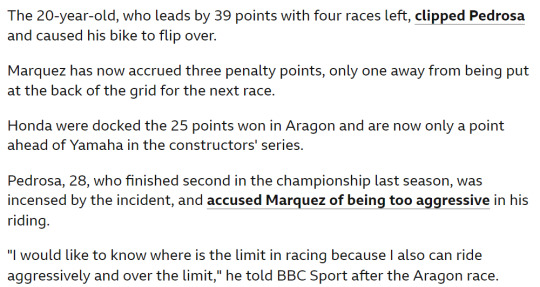
if you think aragon 2013 is unacceptable to the point of being dangerous, then you probably take quite a hard line view and think pretty much any action that could lead to contact needs to be stamped down on. while that contact did have unpleasant consequences for the other party (dani wasn't able to walk for several days and his title bid was basically over), it is perhaps a little worse than could have been reasonably expected in that situation. in that sense, there's a bit of surface level similarity with jerez 2005... there, valentino made the pass for the win at the last corner, knowing he would probably bump into sete while doing so. neither rider is knocked off their bike (though sete has to leave the track) and it is at a slow corner, with relatively 'light' contact. unfortunately, as a result of where valentino's bike impacted sete's body and sete's preexisting shoulder issues, it ended up injuring sete (see here for valentino learning of this perhaps a little later than was ideal and only after he'd taken the piss out of sete for dramatically clutching his arm). at aragon 2013, marc was harrying dani and sticking very close to his rear tyre as he applied pressure to his teammate before he made a small misjudgement, getting his braking a little wrong and clipping the back of dani's bike. he happened to cut a crucial wire in the process, causing dani to highside a few moments later
these aren't equivalent situations and each have their own risk/reward profile. but the basic point is this: inviting contact with another rider will always generate more risk, and can always have unintended consequences... even when the action is relatively innocuous and the rider would not have expected this outcome. if you are in the 'all passes should be clean passes' school, this risk is fundamentally unacceptable. even trickier - what if contact is made as a result of a move you initiated but the other rider could have avoided? of course, you started it, but they could have yielded... and maybe they should have, maybe that would have been the wise, the sensible thing to do in that situation. it's always important to remember that at least two riders are involved in all these situations - and there are many cases where contact and/or crashing is not 100% the fault of any one party. so, for instance, there are several moments in laguna 2008 that are so risky in part because casey is also refusing to yield. that's not to necessarily imply any blame or fault! of course, it might not be ideal for the most aggressive riders being able to bully everyone else as they please because they know they can generally rely on everyone else being more sensible and yielding. but the differing outcomes resulting from the choices made by the 'other' rider will always help influence perception of any race situation - a move that is seen as 'hard but fair' might have been seen as considerably more dangerous if the other party hadn't yielded
and yes... yes, there is absolutely a question of your success rate. this links back to point (1) - is the move plausible? there are moves that aren't really considered examples of 'hard racing' and certainly not dangerous... because they worked. take valentino's last corner move at catalunya 2009, at a corner where you don't traditionally overtake (remember, before the race jorge was going around tempting fate by saying that if you're ahead by that point you're sorted). sure, he goes for a gap that exists, but it could easily have gone wrong - and if a lot of other riders had tried that, then it would have. how do you think yamaha would have felt if valentino had taken both yamaha riders out at the very end of the race to allow ducati to claim an unlikely victory and an increased championship lead? here's another one: misano 2017 and marc making a last lap move in treacherous conditions to snatch the win. no contact required to make that risky as shit - and if stuff like that goes wrong too often they call you an idiot at best and dangerous at worst. of course, both valentino and marc have had moments where they very much did not pull off moves they were intending, which is how we get ambition outweighing talent and 'I hope he can learn from this one and improve for the future', among other hits. but, relative to the amount of risk they're regularly taking in their racing, they get a lot of reward for their troubles... because they're very good at what they do. the risk/reward calculation is one that they... uh, can both be very adept at, but it's also one that's fundamentally easier when you're skilled enough to pull off a lot of moves that would be beyond the capabilities of other riders. it's when you don't know how to judge your moments, when you keep trying moves that you can't pull off - that's where other riders will start having a problem with you
which is where we get to reputation! how different incidents are judged will also depend on the existing reputations of the riders involved and whether they are seen as 'fair' racers or not (an even more nebulous term, if possible), versus hard racers, dangerous racers... often, this is a question of quantity too - with certain riders on the grid, you will notice they're involved in controversial incidents disproportionately often. how likely people are to pay you the benefit of the doubt... how likely they are to believe you as to what your intent was in a certain situation, perhaps the most nebulous concept of them all. 'hard' and 'dangerous' aren't assessments that are made in isolation, and how severely riders are judged will often depend on their pasts and how those pasts are perceived by others
where you get into really sticky territory is... okay, both valentino and marc have more often than not (arguably) been able to stay on the right side of 'the line', where their moves might be hard but aren't putting anyone else in active danger - but that's because they are at least theoretically capable of exhibiting a good sense of judgement and are also good at what they're doing, as covered above. here's a question: do they bear any responsibility for when younger and/or worse riders copy their moves and/or general approach to racing, with worse consequences? when they have been criticised, when they are called dangerous, at times it's not just what they're doing in the moment... it's what they're inspiring. so you've got stuff like this from sete:

even more drastically than that, after the death of a fifteen year old rider in supersport in 2021, one of his fellow rider said this about marc (which marc unsurprisingly strongly pushed back on):
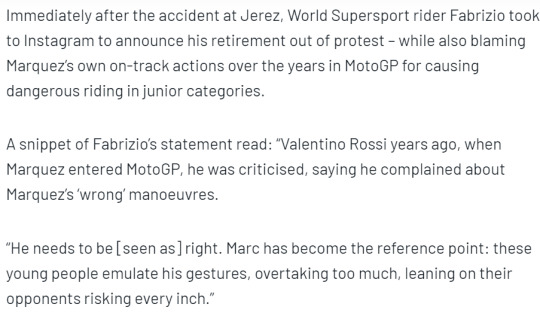
(just worth remembering, this is a rider who did walk away from the sport as a result and was clearly deeply affected by what happened - the marc comments were part of a longer statement that got overshadowed by this part and the resulting controversy)
setting aside the merits or lack thereof of these specific assertions, what of the general questions they raise... can you be a dangerous rider in an indirect fashion like this, by the very nature of your legacy? are riders who helped bring about a more aggressive baseline standard of racing in any way responsible for anything that happens as a result of this standard? (even worse, there's a line of succession here - after all, who was marc's biggest inspiration?) or does individual responsibility reign supreme here? athletes are by design only interested in their own successes, aren't they - and 'legacy' is so abstract, how can anyone know how others will be influenced by what they do? how can we even begin to assess how big an influence individual riders really are? let's not forget that there will be other factors - riders in the past have discussed how particular characteristics of the moto2 class have bred more aggressive racing, or the influence of the size of motogp bikes, or how difficult it is these days to overtake in a completely 'clean' manner, or the rules themselves and to what extent they have actually been enforced etc etc... maybe there's also an element of people focusing on the easiest, most visible explanation in the form of star riders, without giving proper consideration to the underlying factors that will influence an era's style of riding. again, how you feel about all of this will vary from person to person - but part of the hard vs dangerous debate is inherently forward-looking. and it's hardly just legacy... your hard/dangerous moves may also be setting a precedent in the present. to what extent is it the duty of riders to worry about that?
so then, that's what I've got. how you draw the distinction between hard racing and dangerous riding will come down to your individual ideological position and what you think racing even entails. do you think all contact is objectionable? do you think only the most extreme of transgressions - most of which don't qualify as 'racing' per se - should be labelled dangerous? somewhere in between? everyone will draw the line in a different place, according to the situation and their individual biases and understanding of events. it comes down, generally speaking, to how you judge the risks and rewards of a certain move, whether you think what a rider attempted was 'worth' it. all of which depends on whether the rider could realistically have managed whatever action they were attempting, whether the potential rewards were proportionate to the risks, or whether the whole thing was just too flat out dangerous to ever be worth it... of course, none of these are objective standards by which you can assess the racing, but they should give you a rough indication of what people are even talking about when they're distinguishing between hard and dangerous racing. riders as individuals are also far from consistent in their stances (surely not!) so you do have to play it by ear a lot of the times... and while there are plenty incidents where the majority can agree whether it is 'hard' or 'dangerous', there are plenty more where you're going to get a lot of contradictory opinions. no definitive answers here - unfortunately a lot of the time you'll just have to make your own mind up
#is this actually coherent? please write in if it's not coherent#tried to mostly stick to examples I've discussed elsewhere but still feels a bit short on details in places... kinda wishy washy... eh. idk#this is SUCH a vibes thing I cannot stress enough what a vibes thing this is#please don't judge the venn diagrams they were made in two minutes in google slides... not my best work but it'll have to do#smolnerdz#motogp#//#brr brr#batsplat responds#I do find this stuff really tricky myself because. okay so you might not have noticed this but I'm rather fond of both marc and valentino#and I clearly do derive quite a lot of enjoyment from their racing not *in spite* but *because* of their aggression#which is all well and good but it's healthy to always just... engage with the other side of things. ruminate on it a bit#a morally tricky sport to engage with in lots of ways - doesn't mean it all has to be done in only the most self-flagellating of ways#but personally I do feel like you shouldn't just. shut yourself off from the critiques. idk it IS a dangerous sport with real victims#and yet several of the races I've mentioned here made it to a list of my all time favourite races I posted *yesterday*. so now what hm#anyways
42 notes
·
View notes
Text
The Collective Seraphic Writing System
This post is going to be the one dedicated to explaining how the Seraphic writing system works. This writing system is entirely digital, as physical writing is no longer in everyday use throughout the Collective, so it's a bit inconvenient to actually write out. It's also weird to read, because it's written in a way that makes the assumption that you know how to speak and understand Seraphic, but I'll try to explain what I can.
Seraphic has two written forms: longform and shortform. Longform is used primarily to teach young instars how to read and write, and as a way to show how a shortform word is meant to be read. Shortform is the main form of writing, and due to its complication it's usually put off for a year or two before being taught in pupariums. Shortform is the method I'll be teaching today. It's primarily morpho-phonetic, with elements of both an alphabet and grammatical logograms, and is written bottom-to-top and right-to-left in reverse boustrophedon (the path of writing goes up, flips 180°, and goes back down). Because of this, you're expected to be able to read both right-side-up and upside-down. For this post, I'll be using an example sentence to highlight specifics areas of the writing system, as shown below:

It reads: nJasāğn k'œ̄nan ālxōr e-fya.
"There are 16 dull knives on the floor."
There are seven elements you need to be aware of when writing in Seraphic: the alphabet, class cartouches, procedural and plural ligatures, preposition glyphs, tone diacritics, numerals, and punctuation. I'll be going through each one step-by-step.
Alphabet

The alphabet makes up the majority of Seraphic writing. There are 30 consonants and 6 vowels, and they all arrange into syllable blocks called "cells". Each consonant takes one of three forms depending on if it is at the start of the syllable, before a vowel, or at the end of a syllable. The alphabet is featural, meaning that the way each letter is written is meant to encode its pronunciation. Here is the alphabet in full:

Each consonant (excluding the ejectives) showcases the three variant forms it can take (similar to capital and lowercase letters in the latin alphabet). The largest, leftmost character is the form that hosts the interior vowels within it. The rightmost vertical form is used when preceeding another consonant, and the upmost horizontal form is used at the end of syllables. If a syllable contains a syllablic consonant, the main consonant will have no vowel within it and instead a syllable-final form of one of the syllabic consonants (r, l, m, n, or ŋ) placed on top of it.

Concerning vowels, they are solely meant to be written within consonants, acting sort of like internal diacritics. They cannot exist on their own, nor can more than one be written within the same consonant (Seraphic doesn't allow diphthongs), and if a vowel must be written by itself it is written within the glottal stop letter ' (in this instance acting as an independant vowel holder).

These rules apply to individual syllables. In multi-syllabic words, each syllable cell is arranged together in a specific way based on the number of syllables in order to keep the line uniform and compact.
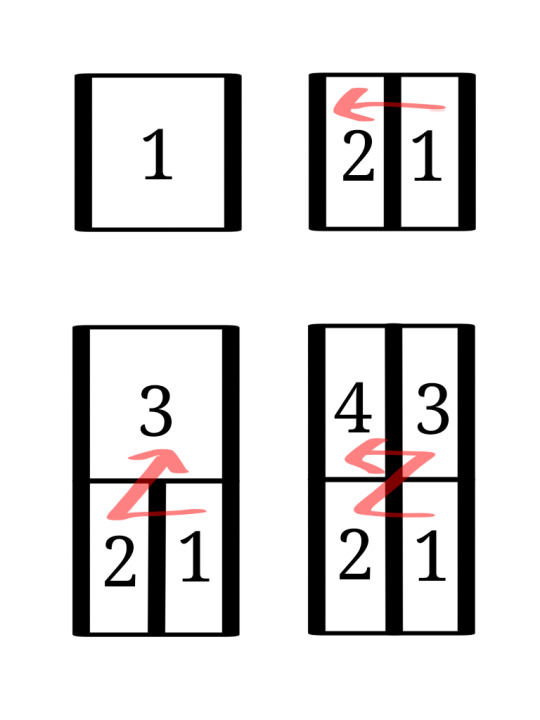
the flow of reading word-internally definitely follows the overall direction of writing (bottom-to-top, right-to-left) so broken down an entire word will usually look like this when written:

Seraphic written in longform will be written entirely using the alphabet. Spaces are put between words, punctuation and numeral symbols are still used, and tone diacritics may be included as well, but otherwise it's entirely spelled out in this way. Writing this way makes the text as a whole quite longer, and can come off as childish or imply you're a new learner of Seraphic, so shortform will usually be used in official contexts. In shortform, alphabetical letters are restricted to non-declined parts of nouns, adjectives, and proper nouns.
Class Cartouches

In Seraphic, there are seven noun classes: Solar (people), Astral (animals), Vital (plants), Terranean (places), Metallic (objects), Lunar (concepts), and Oceanic (everything else). Similarly, the writing system employs seven symbols called "class cartouches" to encode which noun class a word is in. This is drawn from this writing system's predecessor, the Aeonic Seraphic alphabet, that also used glyphs to notate class. These are the seven noun class cartouches:
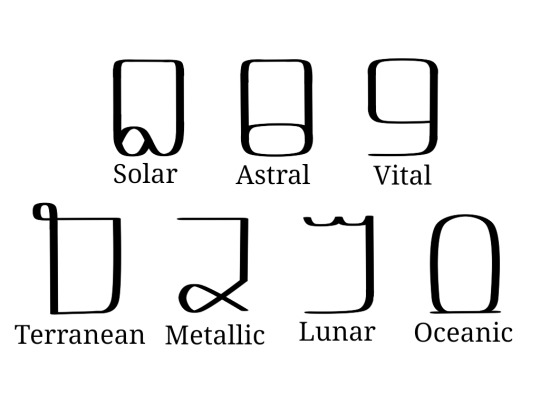
The thing about the class cartouches is, not only is it morphological, but it's also phonetic. A noun is never spelled out in its entirety, usually only part of it is. When a class cartouche is used, it's supposed to stand in for the class prefix itself without having to additionally spell the class prefix in the rest of the word. For example, in the word zājlux (tail), the "-jlux" would be spelled out, and the solar class cartouche would be drawn around it to stand in for the "zā-". Even though you don't write it, you still know it's there because of the class cartouche. Because of the nature of the noun class prefixes, and how many different forms they can take, it can be daunting to have to guess if you're supposed to pronounce a word with a "za-" or a "zo-", but there are patterns to which prefix (and thus, declension patterns), is meant to be read depending on what the following sound is.
Solar class
read as zā before f, v, s, z, c, j, pf, ts, tc and any cluster of two consonants (e.g. zāsā, zāfr, zājlux)
read as zō before x, ğ, h, ', and kx (e.g. zōxō, zōxur, zōğœcl)
read as zē in stressed syllables, and occasionally before consonant clusters (e.g. zēzmp'ux, zēzt'e, zēvasax)
read as s before vocalics (vowels and syllabic consonants), r, l, w, y, n, t, d, p', or k' (e.g. srāc, sēr, sōğœc)
read as ts before t', the ts replacing the t' entirely in pronunciation, for example tsn would be written as (Solar)t'n (e.g. tsn, tsā, tsłzaf)
Astral class
read as ğr before f, v, s, z, c, j, x, ğ, h, pf, ts, tc, kx, p', t', k' and and cluster of two consonants (e.g. ğrzles, ğrxur)
read as x before vocalics, r, l, w, y, ŋ, k, g, p', or t' (e.g. xūc, xŋox)
read as kx before k', the kx replacing k' in pronunciation (e.g. kxa)
Vital class
read as wā before r, l, w, or y (e.g. wāya, wārāc, wāwax)
read as wō before k', k, g, x, ğ, ŋ, or kx (e.g. wōk'ł, wōxur, wō'ōf)
read as wē before consonant clusters (e.g. wēzles, wējlux, wējlozln)
read as ū before n, m, p', p, b t', t, d, f, v, s, z, c, j, pf, ts, or tc (e.g. ūt'u, ūp'n)
read as w before vocalics (e.g. wē, wīn, wājr)
read as wī occasionally before consonant clusters (e.g. wīzya)
Terranean class
read as va before f, v, s, z, c, j, pf, ts, tc and any cluster of two consonants (e.g. vafl, vasērn, vasa)
read as vo before x, ğ, h, ', kx, and consonant clusters (e.g. voxāl, vodsā, vojrayux)
read as vu in stressed syllables and occasionally before consonant clusters (e.g. vujlux, vulvren, vuzajni)
read as f before vocalics, r, l, y, w, m, n, ŋ, p, b, t', or k' (e.g. fe, fruvn, fmağo)
read as pf before p', pf replacing p' in pronunciation (e.g. pfan)
Metallic class
read as ja before f, v, s, z, c, j, pf, ts, tc and any cluster of two consonants (e.g. jafa, javlni, jawaya)
read as jo before x, ğ, h, ', and kx (e.g. joxl)
read as c before vocalics, r, l, w, y, n, t, d, p', or t' (e.g. can, cya, cenaŋx)
read as tc before t', the tc replacing the t' entirely in pronunciation (e.g. tcłvr, tcāŋğl, tcū)
Lunar class
read as la before r, l, w, or y (e.g. lara, layeğr, lalel)
read as lo before k', k, g, x, ğ, ŋ, or kx (e.g. loxir, loğn̄, loxel)
read as le before consonant clusters (e.g. levp'ā, levren, lejt'ān)
read as li in stressed syllables and occasionally before consonant clusters (e.g. liwayi, lit'n̄, livasāx)
read as y before vocalics (e.g. yar, yu, yawu)
read as l/ł before n, m, p', p, b t', t, d, f, v, s, z, c, j, pf, ts, or tc (e.g. lce, łzēwok'u, lvulvren)
Oceanic class
read as a/ā before m, n, p', p, b, t', t, d, s, z, f, v, c, j, pf, ts, tc, w, r, y, l, and all consonant clusters (e.g. ap'i, āt'ē, ācèya)
read as o/ō before ŋ, k', k, g, ', x, ğ, h, and kx (e.g. ōxūr, ōxān)
read as aw/āw before vocalics (e.g. awun, awaf, awaman)
Of course these rules are not hard set, and there are several instances where a written word contradicts these rules or even when two words end up spelled the same, but for the most part these rules will generally be consistent for most written words. It seems like a lot to remember, but usually it's a thing that you eventually develop a sort of "ear" for.

Procedural and Plural Ligatures

The procedural and plural ligatures are additional glyphs used to mark, respectively, the procedurals and the plurals of a noun. The procedural are written at the bottom of the noun (since Seraph is written bottom-to-top and these are prefixes of course), and there are 12 separate procedural symbols in use. Similarly, the plurals, being suffixes, are written at the top of the noun and contain only three symbols (the singular is usually unmarked). They are as follows:
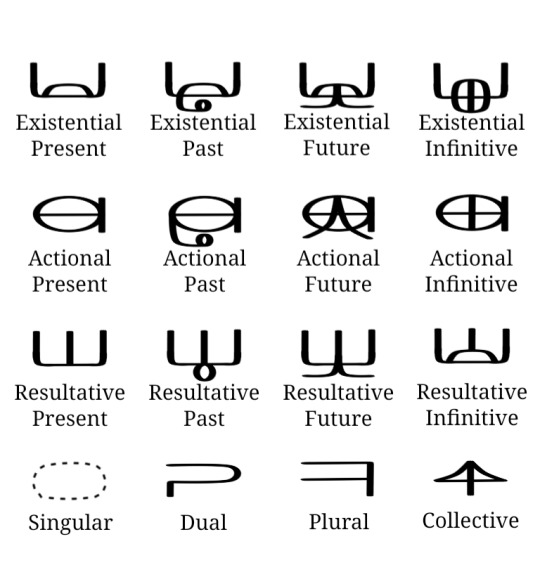
The plural ligatures attach to both nouns and adjectives freely, but in order for a procedural ligature to attach to an adjective, the adjective needs to be put in the oceanic class and subsequently written with the oceanic class cartouche. Additionally, if you want to write remote past/future forms for each procedural, you would need to attach the resultative present ligature underneath the preexisting past or future ligature (these conjugations haven't developed their own separate ligature forms, so they follow the tradition of using the resultative in addition as semantically that is where the remote forms originated). I don't really have a way to show you how to pronounce the plural forms, as even though the different pronunciations are pretty few they're actually pretty inconsistent on which one goes where. It's just one of those things you kinda have to already know. You can check the introduction to Seraphic post to see what forms the plurals can take, but otherwise it's basically, like, memorization. The procedurals on the other hand DO have a predictable pattern of pronunciation, but each tense has a different form based on what class and declension the noun is in, and with six tenses and seven classes each with at least three different declension forms, it's definitely something I can't summarize here. Again I HAVE to make a separate post for that because the declension forms are vital to knowing how to decline properly in Seraphic.
Preposition Glyphs

This section will probably be the easiest to explain really. The preposition glyphs are pretty easy to recognize. They're written in between words, attaching to both of them instead of floating freely like regular words are. There are 19 glyphs for the 19 prepositions, and they don't really change form. Sometimes, if occurring at the beginning of a sentence, they'll have one end sorta lopped off, but not everyone follows through with this convention. Here are the glyphs listed below:
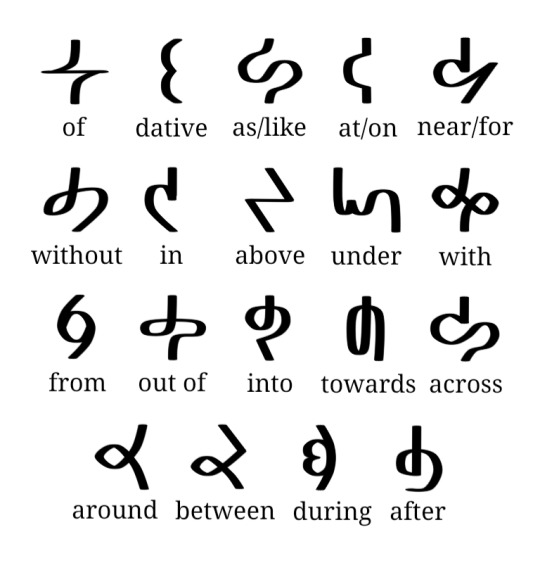
Two or more prepositions can't occur sequentially, it's a very one-at-a-time situation, although in colloquial speech you'll see two prepositions being used in certain instances.
Tone Diacritics

Seraphic is a tonal language, and luckily it has diacritics to indicate the tones. They frame the words on each size, being used on both nouns and adjectives where applicable. You'll usually see them in formal contexts like government documents and letters of address, on signs and boards and menus and any kind of display especially in highly populated areas, in use by those whom are just learning Seraphic and don't have a hang on remembering all of the tones yet, and just in any context where clarity of literacy would be important. In everyday colloquial text conversations and things the tone diacritics will be usually dropped as context is sufficient enough to know, although tone diacritics may be reintroduced to differentiate homonyms that are distinguished only in tone (e.g. lxal "power" vs. łxāl "day"). There are eight individually recognized tone diacritics:

The low tone is the base tone and is usually left unmarked, so there's no sign for just the low tone. When a low tone transitions to a rising or falling though, the low transition diacritic will be used to connect the two. Many of these diacritics are usually connected consecutively when a word requires it, flowing as if they're one larger tone diacritic. This can give a whole host of unique tone symbols, but for the most part, all of the tone symbols can be broken down officially into the 8 diacritics. There isn't a 1-1 correspondence between individual tone diacritics and syllables within a word, usually you can know from context and just knowing how the word is pronounced. For example, the word łxāl would be written with one high tone marker even though the word is two syllables, but it's meant to infer that the entire word is pronounced with an even high tone. Here are some additional examples:
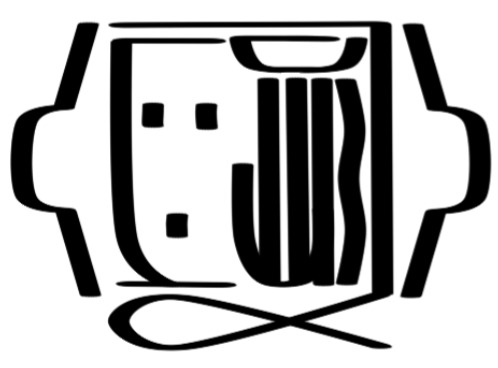
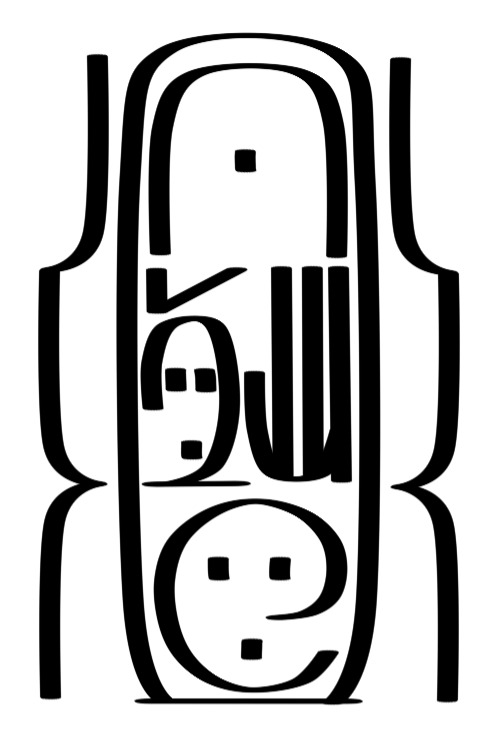
The top example is the word jalzègxa "chronicle". You can see that it uses the two low tone transitions to connect to the central falling tone, representing a low-falling-low relationship. The word below that is māzefādnu "hourglass". It employs a high-low-high, and then a high-low, with the last high-low meant to merge with the high-low-high. So truthfully it's meant to be interpreted as high-low-high-low. There's a lot of possibilities, but breaking it down will simplify what tones are being used specifically.
Numerals and Punctuation

This final section will discuss Seraphic numerals and punctuation. Now, unlike in most human languages which uses base-10, having 10 unique symbols to represent the values of 0-9, Seraphic uses base-16 and represents the values 1-16 with 16 individual symbols. In base 16, we would write 16 as 10, standing for one set of 16 and zero sets of 1. It's written in positional notation like arabic numerals, where each position represents a power of 16 (instead of a power of ten like in base-10). Here are the numerals:
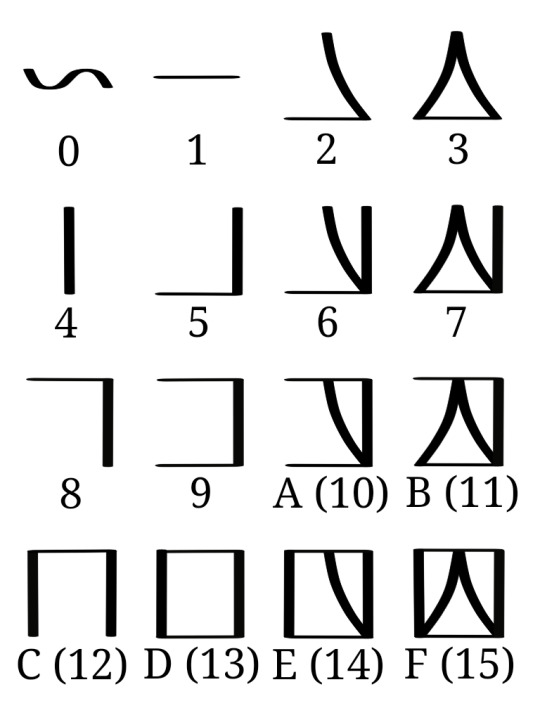
If you were to write a number like 299,792,458; you'd convert it into base-16 which would be 11,DE7,84A; and since Seraphic numerals are grouped in 4 instead of 3 it would actually be 11DE,784A. This is how you'd write that:
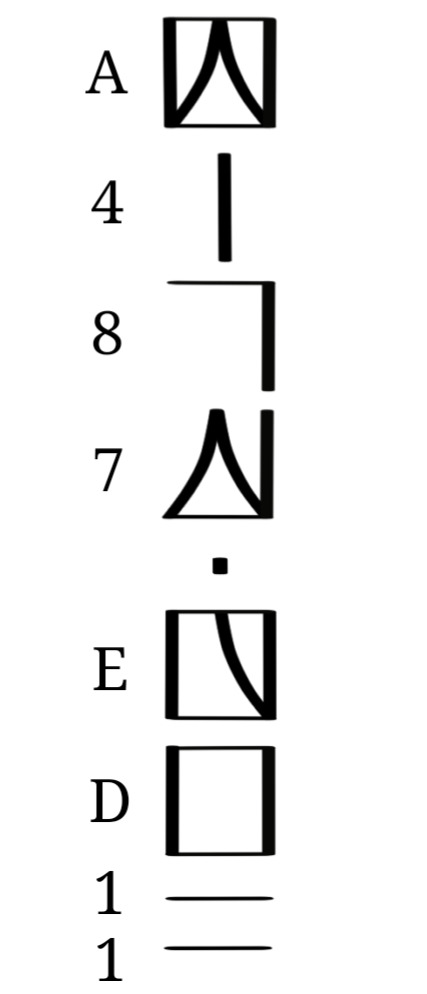
Both Arabic numerals and Seraphic numerals describe the same amount of things, they just group things differently. We group in sets of 10, they group in sets of 16.
As for punctuation, there are only 5 marks that's in standard use, and these are them:
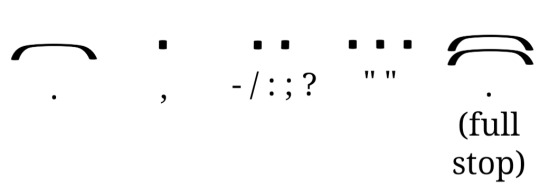
Single bar - separates individual sentences.
Single dot - separates clauses for clarity, separates numerals into groups of four.
Double dot - separates individual words such as in lists or replaces a single dot when separating clause groups.
Triple dot - Distinguishes quotes and dialogue, as well as highlighting names, terms, and titles.
Double bar - used to end full paragraphs/passages instead of a single bar.
Overall, that's pretty much everything I can detail about how the Seraphic writing system works! It's complicated but it was very fun to develop and boy was it satisfying to get it to work. Hopefully you'll now be able to decode a little better Seraphic writing, and maybe even write something of your own!

ŋKowīci cu-stux 'ōf tsa-levp'ā cu-zāsláf pi-lizt'n ğōdjasa! (Thank you all so much for reading!)
#conscript#constructed script#neography#conlang#constructed language#artlang#writing system#orthography#seraphic#collective seraphic#whoa boy this one is even longer#had to do a lot of writing and doodles for this#of course i needed them so itd all make sense#i needed to provide examples#either way i hope this made any sort of sense#ill provide the declension forms soon enough and that should be relatively shorter#idk if it'll be easier to explain though#eh whatever
49 notes
·
View notes
Text
SMSW Day 1: Side, Minor, One-Off Character
ITS OUR GIRL TRIPLE X-MAS
I've had motivation to edit so I just made a simple edit in like.....a few minutes so if it sucks blame it on the fact it's early
@seemoreseymoursbay
#we all say “it was a quick lazy *blank*” to excuse the fact it sucks#thats just fact#seemoreseymoursweek#see more seymour's week#smsw#smsw side#bob's burgers#bobs burgers#tell me if i forgot anything 😅 i feel like i did#i already have an idea on what i might do tomorrow (also an edit because i have 1 talent) but i need to know any wlw ships...#eh I'll figure it out#(forgot they cant be ships with weeeks fuckkkk...yknkw what it'll work itself out..probably)#my edit#capcut edit#fandom edit
23 notes
·
View notes
Text


i think these two should kiss actually
#epic battle fantasy#ebf#ebf anna#ebf lance#i am playing the game and man it is a bit frustrating to do so on phone but eh. it'll do
13 notes
·
View notes
Note
I do gotta say tho, even tho I’m mad at aziraphale because he’s being a terrible boyfriend like what you said about the “I forgive you like” because WHAT. But also I really like the way the show really demonstrates the underlying cruelty of heaven and it’s angels. Really shows the hypocrisy of a group of beings who are supposed to do good, especially aziraphale who really buys into the heaven propaganda, who hurts people, particularly the person who means the most to him. Because like you said he fully just takes advantage of that devotion Crowley has for him. Insane, this shwo makes me INSANE
I missed this anon and yeah! The angels were one of my favourite parts of the season, and I think the strongest element aside from Neil Gaiman deciding he's just a simple man who wants to put his otp in situations. They are deeply awful and I kind of love them. They are the exact kind of moralizing hypocrites who are callous and cruel precisely because they think being on team good means everything they do is justified and it's actually impossible for them to be in the wrong (they're angels! is it even possible for them to do the wrong thing?).
but!! To me, they also seem like they're basically kids? Obviously they're not literally children, but there is this very consistent reoccurring joke about how childish/sheltered/immature they are. Muriel is the most obvious example, but the archangels come off like bratty twelve year olds to her sweet little kid.
Gabriel is basically teenager in love flipping off his family as he runs away with his backstreet guy. Uriel is constantly picking at Michael, Michael is playing at being in charge like it's a game, and it's ridiculously easy for both Aziraphale and Crowely to trick them obvious half assed lies. They're not allowed to ask questions! The Metatron treats them like badly behaved kids out past their curfew. At any point an old man with a beard may pop up to scold them and send them home, and they're all scared of doing something wrong by his standards and getting in trouble with this guy who is pointedly not God but who lines up exactly with the pop-culture idea of god the father, and who offers Aziraphale, among other things, a respite from the hard work of figuring out what the right thing to do is for himself. It's fine! You don't have to question the belief system you were born into or make a painful break with everything you've ever known! Aziraphale has had six thousand years on earth to grow up, but the other angels have been sitting in a sterile white box playing "i'm not touching you" games with each other and filing paperwork.
And I think that's extra interesting because this season also really emphasizes:
Heaven has Institutional Problems
Aziraphale isn't the only angel who's unhappy in heaven. Gabriel and Muriel were both completely miserable. They just didn't understand that they were unhappy because they'd never experienced anything else.
Angels who aren't Aziraphale can change and grow! There's very explicitly Gabriel being changed by love and Muriel growing up a bit on earth, and from a more fan-theory angle there's also Jimbriel, who I think is probably basically Gabriel minus the war and six thousand years of playing referee for Michael and Uriel while unleashing an assortment of plague and calamities on earth because that's God's will! Buck up champ.
We also get Gabriel and Beezelebub talking about how their underlings basically live for Armageddon, "if you can call that living." This is so bleak. They've all been on a six thousand year time out just dreaming of the day they get to beat the shit out of each other until they feel better, but it won't work because eternity is just more of the box.
Anyway I think it's going in a distinctly eden adjacent direction. Aziraphale is going to tempt those angels with knowledge and the capacity for change. I have veered so far from your ask anon i'm sorry you're right heaven really went all out on sucking this season & while Crowley and Aziraphale are both fucking it up Crowley refrains from being spectacularly cruel to Aziraphale about it and Aziraphale should learn to return the favour. I forgive you!! I forGIVE you. I forgive YOU. "you can be an angel again" is actually a worse thing to say than "you're a demon. i don't even like you." when he finally picks crowley over heaven i'm going to lose my mind.
#good omens spoilers#good omens season two spoilers#idk it makes me sad that i didn't like the humans very much this season because i think ideally they're central to this whole how to be#a person question i also hope we get to see more of hell next season because i do think they're stuck in basically the same place#with a different aesthetic! and the stick being#thrown into a torture pit instead of thrown into hell#or like. mindwiped and locked in an office for all eternity#gabriel broke my heart which is embarrassing but when he goes from not even understanding what music is to experiencing#the simple pleasure of sharing a song with someone for the very first time and almost immediately hits repeat for eternity... baby. baby bo#i would also like more crowley! this was very much the season of aziraphale#which is fine but i missed him yelling questions at god and the bits where it seemed he really wanted aziraphale's opinion instead of just#wanting aziraphale to develop better opinions#next season had better be crowley wrestles with the universe i am telling you!!!#remember three months ago when i was like eh... another good omens season#i bet it'll be cute but i'm content with my book#i don't go here i said strapping on my clown shoes#seriously though i do think crowley is scared to admit to wanting to be good both because god rejected him and he doesn't want#to be a sucker for her (he is only interested in being a sucker for aziraphale)#and like. chase after something he's barred from and has already been told isn't for him.#and that's why it's so hard for him to admit even to himself that he too would be unhappy ditching earth#in ways that parallel aziraphale's unwillingness to let go of heaven as a source of moral authority and goodness#but the way aziraphale goes oh no! i cannot trust my own judgement and desires. They are suspect!#my judgement is that crowley is good and also funny and sexy. my desires are for his company and also his body#therefore the source of these desires is also maybe bad. i mean he's a demon. he's got to be bad#right??? but no. but i saw him do a good thing. but maybe i didn't? I should probably take a stance on this.#and he makes this crowley's problem until the apocalypse but then the second he gets the chance to cram crowley and his feelings for him#back in a heaven approved box he jumps at it in a way that requires just being WILDLY insensitive and dismissive of crowley's feelings#he's not just being a dick about their relationship he is being a dick about crowley as a person. and he should know better but is choosing#not to because he wants the easy out so badly. anyway i love him he was my favourite character all season no notes#good omens
42 notes
·
View notes
Text
Jashtober Day 18- Monarch
[tw blood]
-

I think bro should have a torn crown. For like a metaphor or something
More alt ones v


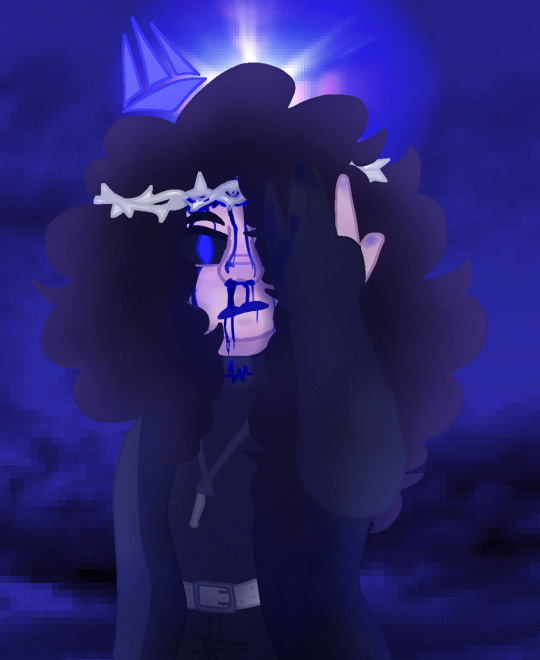
#Didn't turn out how I wanted it too but it'll do#had an idea like this before Jashtober so was happy to finally do it at least#wish it was better but eh its fine the way it is i guess#also no he isnt jesus#i realize that pfft#mind is jesus arc when/j#mind dies for our hearts sins#chonny jash#chonnys charming chaos compendium#cj mind#jashtober#jashtober day 18#-atlas art-#//blood#tw blood
29 notes
·
View notes
Text
I LIED i'm actually back between episodes 79 and 80 hehe
things are going south and i live for it
#no spoilers beyond episode 79 pls#delirium michael is being mischievous and i like it#something somethin no one is protected in the tunnels and i want to watch jon get hunted down for sport#i do think i remember seeing a metal pipe somewhere in a fanart i probably shouldn't have seen#luckily i don't remember who was at the end of said pipe so it'll be a surpise#maybe it's jon's metal pipe and he'll be smashing someone's head in#that'll make him go higher in my esteem#like i said i like criminals#'come out come out wherever you are'#i can only hear this in annie's voice from league of legends which absolutely destroys the terrifying intent of the sentence#ok so elias is the eye but jon also is the eye and now i'm even more confused#or is elias the big eye and jon the small eye directed by the big eye?#eh answers will come in due time ig#don't tarnish my ignorance prematurely#tma#the magnus archives#tma spoilers
8 notes
·
View notes
Text
.

well i have no idea if anyone will even like this fic but im having fun
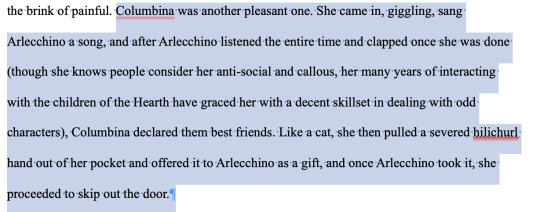
we're going full throttle into the different segments again too

#miscellaneous#wrote 1k tonight AND got edits done so that's something#it's def turning out to be much more of character explorations#how i want to end the thing is still muddied (as in what themes to tie up) but an overall idea#the question is still if i want to include pantalone and dottore POVs#and i think what i will do is have the main story --side a-- be in Arle's pov#and then 'side b' will be bonus content; dottolone scenes in their povs#because i mean it's a fic. by nature it's self indulgent. so fuck it why not#but we still got a lot of work (and scenes)#maybe it'll be like 20k total?? more than that with the 'side b'??#got a lot more writing first before i figure that out (and even consider posting)#but i know how the ao3 ''''algorithm'''' work#like there isnt one but you gotta game the system if you want your fic noticed#not posting all at once. weekly consistent updates. commissioning an artist to draw art for it#eh *waves hand* that's a several months out from now endeavor
7 notes
·
View notes
Text
I needed a minimum of 6 pictures for a Hinge account so I just took this, here you go

#i look a little unkempt at the moment but eh screw it#decent shot of my eyes though so it'll do#at least it's authentic?#sethposting#my face
5 notes
·
View notes
Text

indie sophia "sophie" maria beckett from julia quinn's bridgerton series. cared for by nicole. sideblog to @firstd0wn.
#indie bridgerton rp#bridgerton rp#indie oc rp#indie regency rp#indie fantasy rp#self promo.#eh it'll do
6 notes
·
View notes